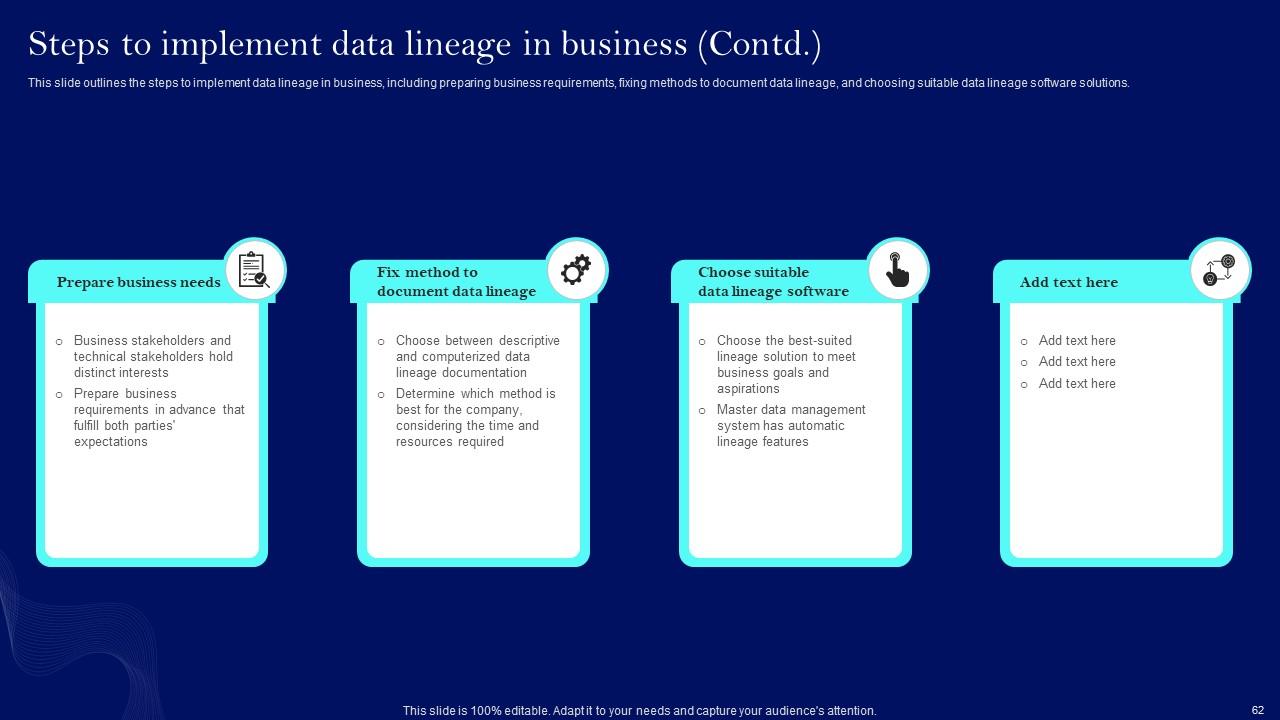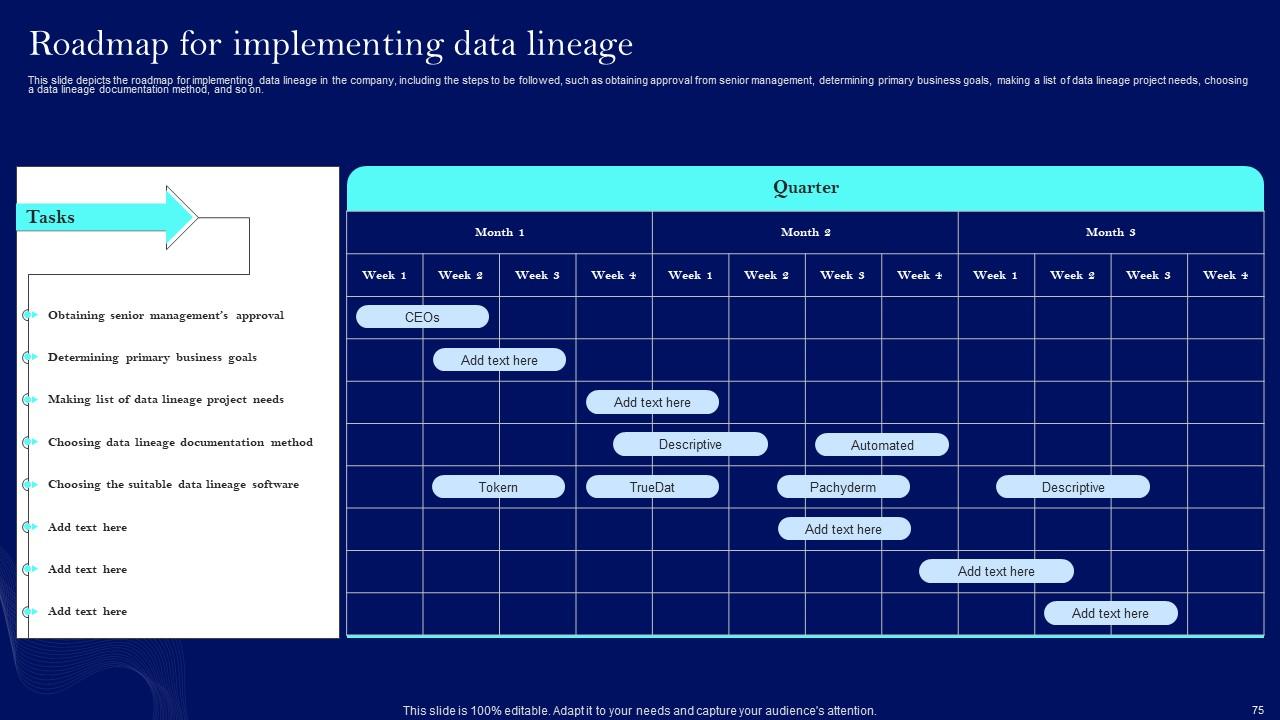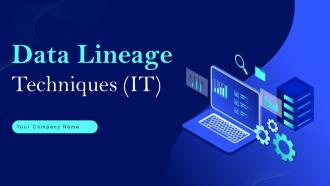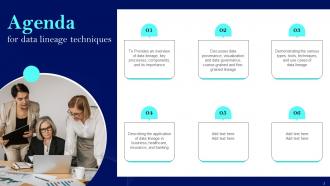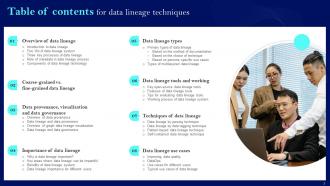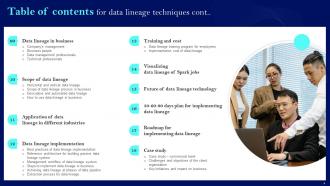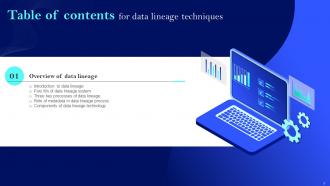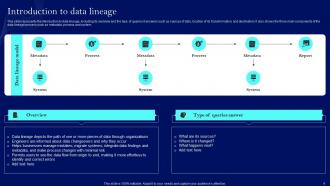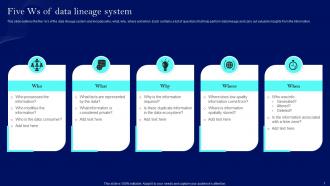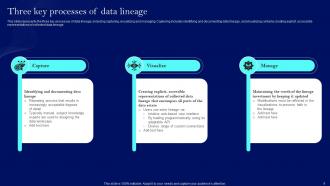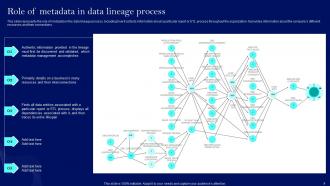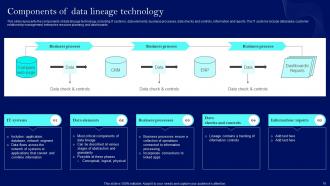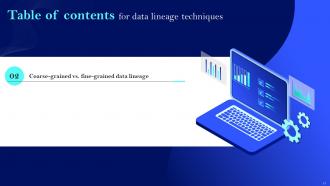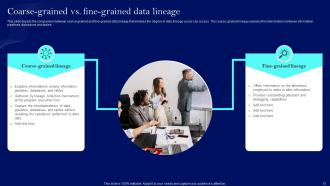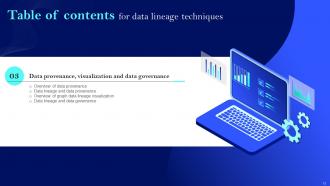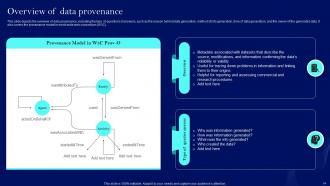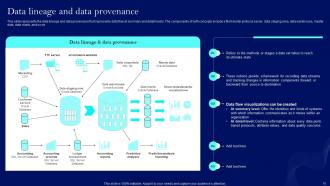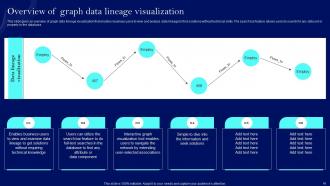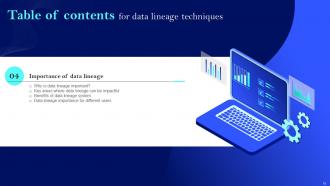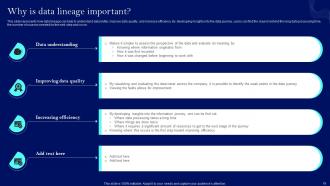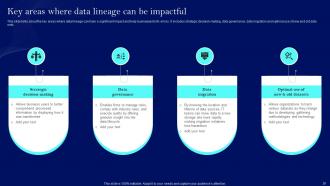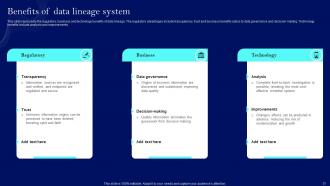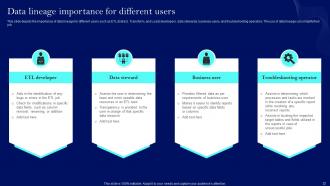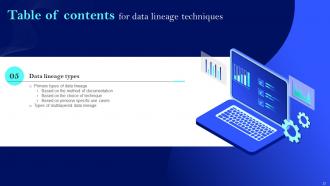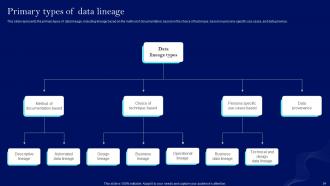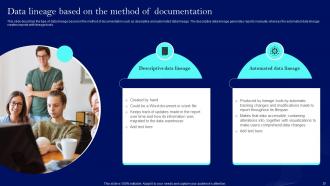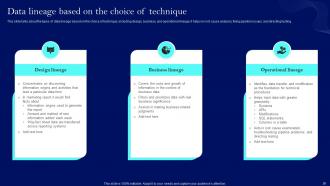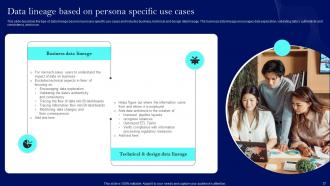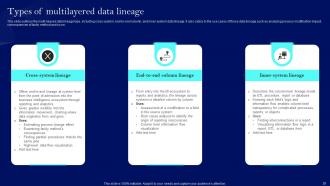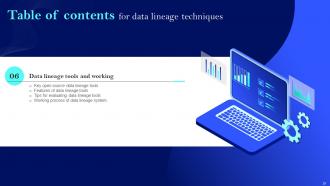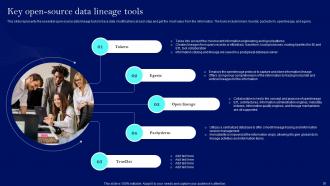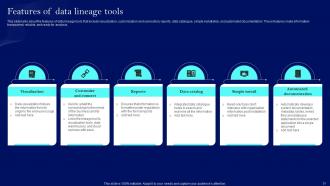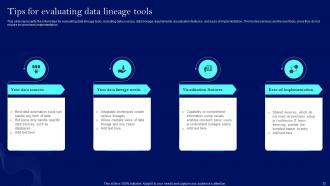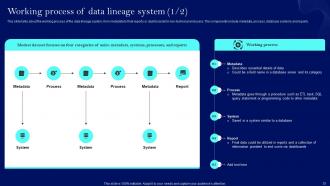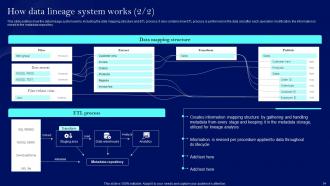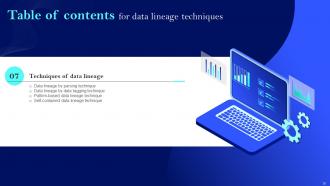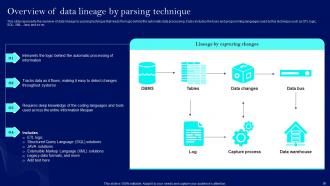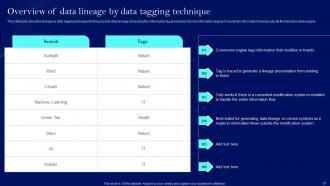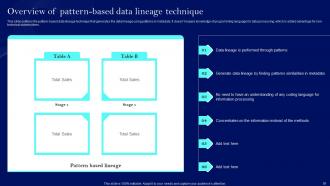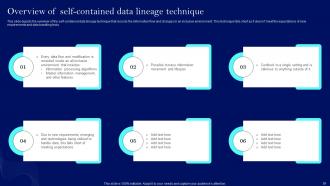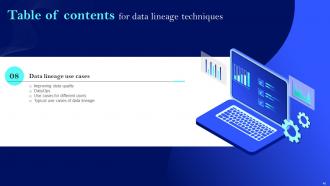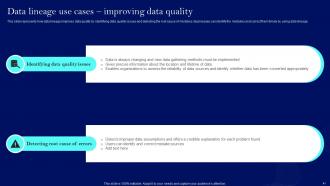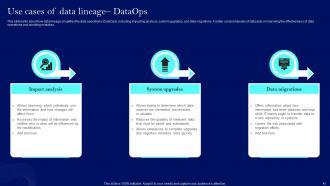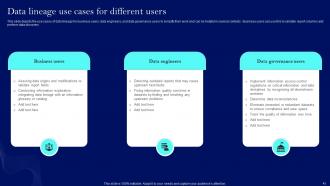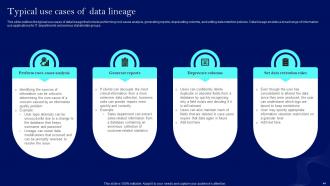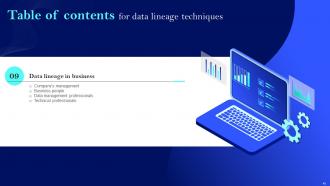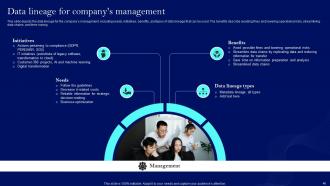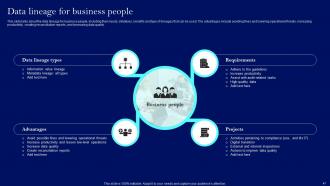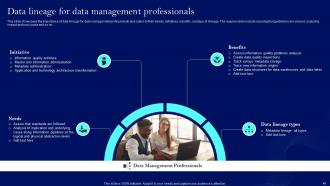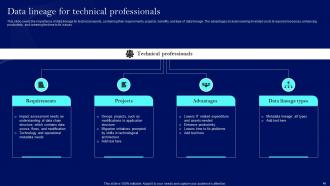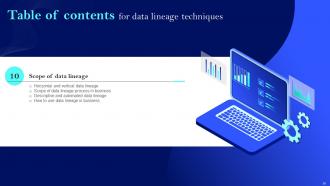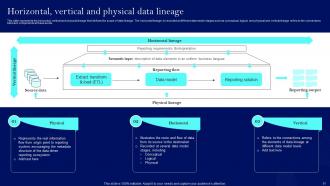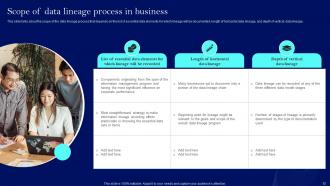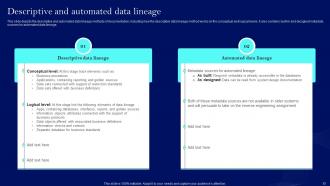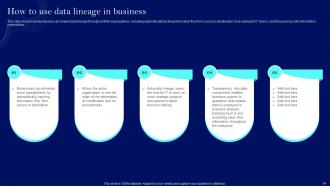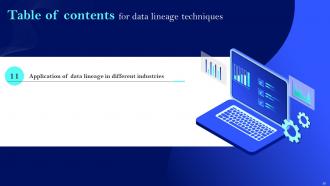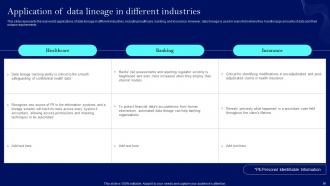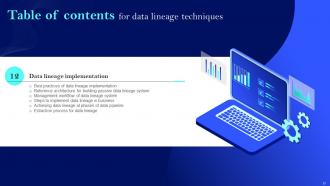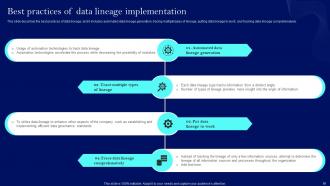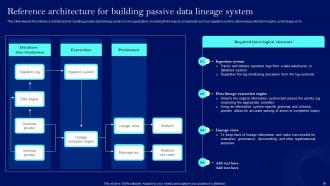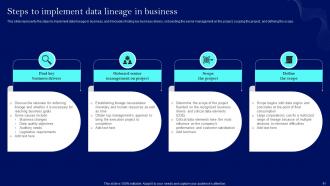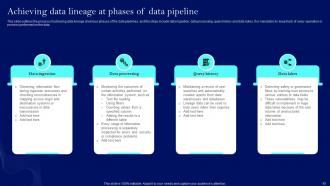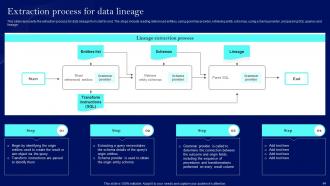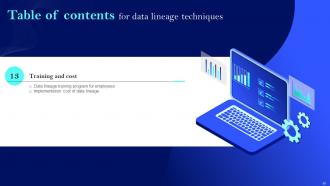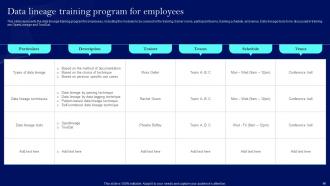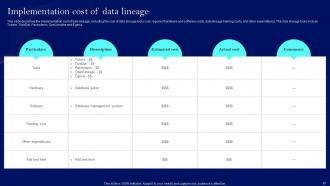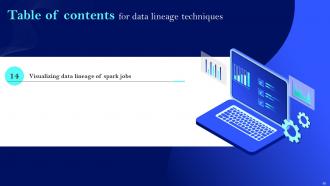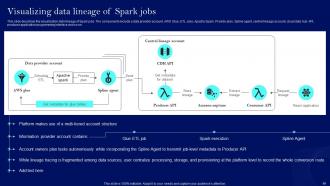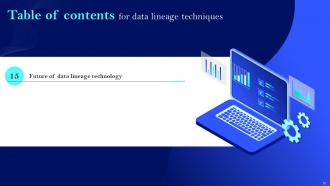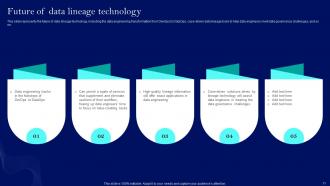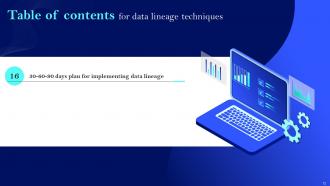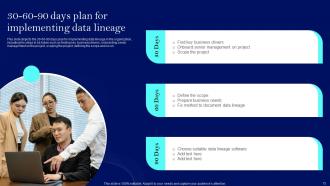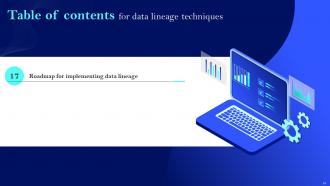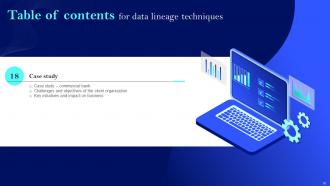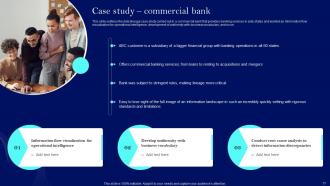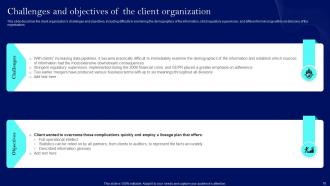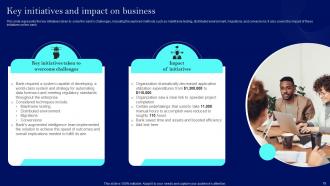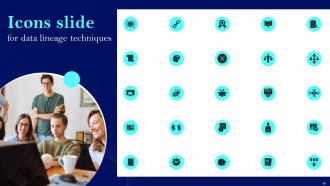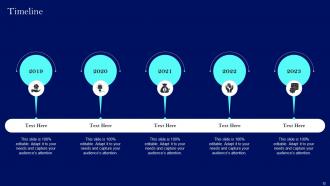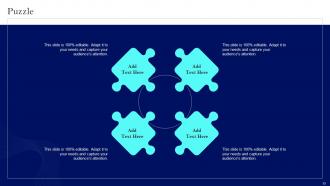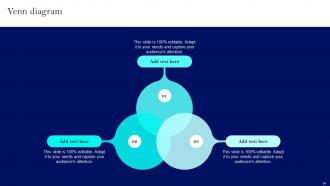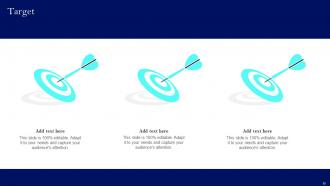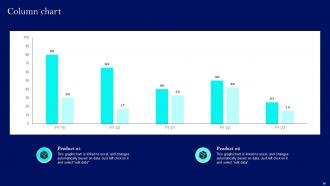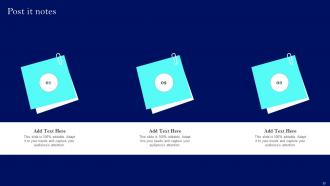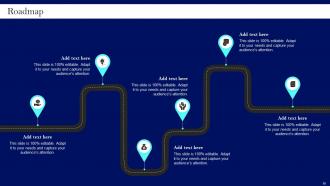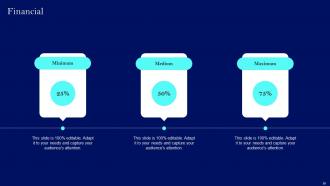Data Lineage Techniques IT Powerpoint Presentation Slides
Explore the world of data lineage and its vital relationship with data governance through our comprehensive Data Lineage PowerPoint Presentation. Our expertly crafted ETL Data Lineage deck covers a wide range of topics, including the introduction to data lineage, the five Ws who, what, when, where, and why, key processes, the role of metadata, etc. It goes even further by comparing coarse-grained and fine-grained data lineage, data provenance, visualization, and the intersection of data lineage with data governance. We emphasize the importance of data lineage, highlighting its impact across various areas and the benefits it offers to different users. Our Data Lineage Importance PPT also explores different types of data lineage based on documentation methods, technique choices, persona-specific use cases, and multilayered data lineage. Furthermore, it provides insights into data lineages tools, workings, and techniques, including parsing, data tagging, pattern-based approaches, and self-contained methods. Lastly, our Data Lineage Techniques module offers a forward-looking perspective on data lineage technology, a 30-60-90 day plan, a roadmap, and a compelling case study featuring a commercial bank to provide a glimpse into the future. Get instant access.
You must be logged in to download this presentation.
PowerPoint presentation slides
This complete presentation has PPT slides on wide range of topics highlighting the core areas of your business needs. It has professionally designed templates with relevant visuals and subject driven content. This presentation deck has total of ninty slides. Get access to the customizable templates. Our designers have created editable templates for your convenience. You can edit the color, text and font size as per your need. You can add or delete the content if required. You are just a click to away to have this ready-made presentation. Click the download button now.
People who downloaded this PowerPoint presentation also viewed the following :
Content of this Powerpoint Presentation
Slide 1: This slide introduces Data Lineage Techniques (IT). Commence by stating Your Company Name.
Slide 2: This slide depicts the Agenda of the presentation.
Slide 3: This slide includes the Table of contents.
Slide 4: This slide continues the Table of Contents.
Slide 5: This slide states the Title for the Topics to be covered further.
Slide 6: This slide represents the introduction to data lineage, including its overview and the type of queries.
Slide 7: This slide outlines the five ‘w’s of the data lineage system and includes who, what, why, where and when.
Slide 8: This slide presents the three key processes of data lineage, including capturing, visualizing and managing.
Slide 9: This slide displays the Role of metadata in data lineage process.
Slide 10: This slide highlights the components of data lineage technology.
Slide 11: This slide exhibits the Heading for the Contents to be discussed next.
Slide 12: This slide depicts the comparison between coarse-grained and fine-grained data lineage that involves the degree of data lineage a user can access.
Slide 13: This slide portrays the Title for the Ideas to be covered in the upcoming template.
Slide 14: This slide displays the Overview of data provenance.
Slide 15: This slide represents the data lineage and data provenance that represents data flow at summary and detail levels.
Slide 16: This slide gives an overview of graph data lineage visualization that enables business users to view and analyze data lineage.
Slide 17: This slide talks about Data lineage and data governance.
Slide 18: This slide presents the Heading for the Ideas to be discussed next.
Slide 19: This slide represents how data lineage can help to understand data better, improve data quality, and increase efficiency.
Slide 20: This slide talks about the key areas where data lineage can have a significant impact and help businesses to fix errors.
Slide 21: This slide represents the regulatory, business and technology benefits of data lineage.
Slide 22: This slide depicts the importance of data lineage for different users.
Slide 23: This slide reveals the Title for the Contents to be covered in the upcoming template.
Slide 24: This slide represents the primary types of data lineage.
Slide 25: This slide describes the type of data lineage based on the method of documentation such as descriptive and automated data lineage.
Slide 26: This slide talks about the types of data lineage based on the choice of technique, including design, business, and operational lineage.
Slide 27: This slide describes the type of data lineage based on persona-specific use cases and includes business, technical and design data lineage.
Slide 28: This slide outlines the multi-layered data lineage type.
Slide 29: Thsi slide states the Heading for the Topics to be discussed further.
Slide 30: This slide represents the essential open-source data lineage tools to trace data modifications at each step.
Slide 31: This slide talks about the features of data lineage tools.
Slide 32: This slide presents the criteria tips for evaluating data lineage tools.
Slide 33: This slide talks about the working process of the data lineage system, from metadata to final reports or dashboards for non-technical end users.
Slide 34: This slide outlines how the data lineage system works, including the data mapping structure and ETL process.
Slide 35: This slide includes the Title for the Topics to be covered in the following template.
Slide 36: This slide presents the Overview of data lineage by parsing technique.
Slide 37: This slide talks about the lineage by data tagging technique that represents data lineage.
Slide 38: This slide outlines the pattern-based data lineage technique that generates the data lineage using patterns in metadata.
Slide 39: This slide depicts the overview of the self-contained data lineage technique that records the information flow and changes in an inclusive environment.
Slide 40: This slide portrays the Heading for the Contents to be further discussed.
Slide 41: This slide represents how data lineage improves data quality by identifying data quality issues and detecting the root cause of mistakes.
Slide 42: This slide talks about how data lineage simplifies the data operations (DataOps).
Slide 43: This slide depicts the use cases of data lineage.
Slide 44: This slide outlines the typical use cases of data lineage.
Slide 45: This slide portrays the Title for the Ideas to be discussed in the upcoming template.
Slide 46: This slide depicts the data lineage for the company’s management.
Slide 47: This slide talks about the data lineage for business people.
Slide 48: This slide showcases the importance of data lineage for data management professionals.
Slide 49: This slide covers the importance of data lineage for technical experts.
Slide 50: This slide reveals the Heading for the Ideas to be covered in the upcoming template.
Slide 51: This slide represents the horizontal, vertical and physical lineage that defines the scope of data lineage.
Slide 52: This slide talks about the scope of the data lineage process that depends on the list of essential data elements.
Slide 53: This slide depicts the descriptive and automated data lineage methods of documentation.
Slide 54: This slide shows how businesses can employ data lineage throughout their organizations.
Slide 55: This slide contains the Title for the Contents to be further discussed.
Slide 56: This slide represents the real-world applications of data lineage in different industries.
Slide 57: This slide highlights the Heading for the Topics to be covered next.
Slide 58: This slide describes the best practices of data lineage.
Slide 59: This slide depicts the reference architecture for building passive data lineage system in an organization.
Slide 60: This slide represents the management workflow of the data lineage system.
Slide 61: This slide states the Steps to implement data lineage in business.
Slide 62: This slide continues the Steps to implement data lineage in business.
Slide 63: This slide outlines the process of achieving data lineage at various phases of the data pipelines.
Slide 64: This slide presents the extraction process for data lineage from start to end.
Slide 65: This slide exhibits the Title for the Topics to be further discussed.
Slide 66: This slide represents the data lineage training program for employees.
Slide 67: This slide describes the implementation cost of data lineage.
Slide 68: This slide highlights the Heading for the Contents to be covered in the upcoming template.
Slide 69: This slide describes the visualization data lineage of Spark jobs.
Slide 70: This slide mentions the Title for the Ideas to be discussed further.
Slide 71: This slide represents the future of data lineage technology.
Slide 72: This slide exhibits the Heading for the Ideas to be covered next.
Slide 73: This slide depicts the 30-60-90 days plan for implementing data lineage in the organization.
Slide 74: This slide states the Title for the Contents to be discussed next.
Slide 75: This slide depicts the roadmap for implementing data lineage in the company.
Slide 76: This slide portrays the Heading for the Topics to be covered next.
Slide 77: This slide outlines the data lineage case study carried out in a commercial bank.
Slide 78: This slide describes the client organization's challenges and objectives.
Slide 79: This slide represents the key initiatives taken to solve the bank's challenges.
Slide 80: This is the Icons slide containing all the Icons used in the plan.
Slide 81: This slide is used for displaying some Additional information.
Slide 82: This slide exhibits the company's Timeline.
Slide 83: This is the Puzzle slide with related imagery.
Slide 84: This is the Venn diagram slide.
Slide 85: This slide depicts the organization's Targets.
Slide 86: This slide reveals the Column chart.
Slide 87: This slide contains the Post it notes for reminders and deadlines.
Slide 88: This slideshows the Roadmap of the organization.
Slide 89: This slide elucidates information related to the Financial topic.
Slide 90: This is the Thank you slide for acknowledgement.
Data Lineage Techniques IT Powerpoint Presentation Slides with all 95 slides:
Use our Data Lineage Techniques IT Powerpoint Presentation Slides to effectively help you save your valuable time. They are readymade to fit into any presentation structure.
FAQs
Data lineage is a process that tracks and documents the data flow from its origin to its final destination. It includes information about the type of queries, the five 'w's (who, what, why, where, and when), the key processes (capturing, visualizing, and managing), and the role of metadata in the data lineage process.
Implementing data lineage in businesses offers several benefits, including a better understanding of data, improved data quality, increased efficiency in data operations (DataOps), root cause analysis of data quality issues, and the ability to fix errors and mistakes more effectively.
There are several types of data lineage, including coarse-grained and fine-grained data lineage based on the degree of access a user has, descriptive and automated data lineage based on documentation methods, and design, business, operational, technical, and multi-layered data lineage based on use cases and techniques.
Data lineage can be visualized using graph data lineage visualization, which allows business users to view and analyze data flow in a clear and intuitive manner. It provides insights into the data lineage at both summary and detail levels.
The scope of data lineage in organizations includes horizontal, vertical, and physical lineage, defining the extent of data lineage coverage. It also depends on the list of essential data elements and can be employed throughout the organization to improve data management, data quality, and decision-making processes.
-
I loved the hassle-free signup process. A few minutes and, I had this giant collection of beautiful designs.
-
Excellent Designs.































































